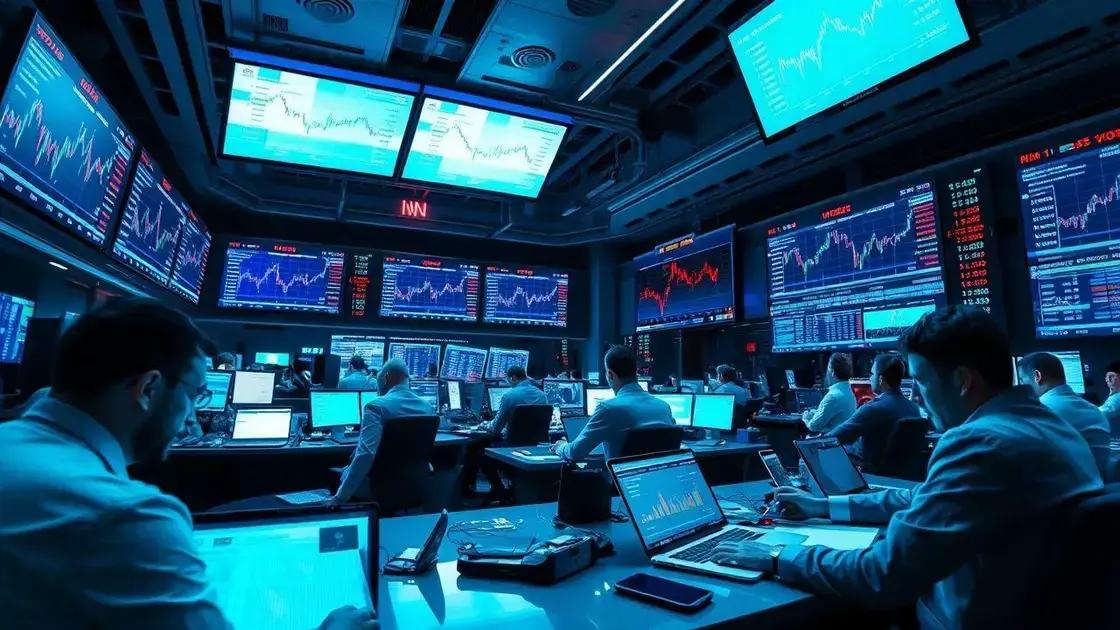Economic forecasts: what to expect in the coming years

Understanding economic forecasts is crucial for navigating financial decisions, as these predictions are based on key indicators that inform businesses and individuals about potential future economic conditions.
Economic forecasts can seem like a crystal ball predicting our financial future. But how reliable are these predictions? In this article, we’ll dive into what to consider when reviewing these forecasts and their real-world implications.
Understanding economic forecasts
Understanding economic forecasts is essential for anyone looking to navigate financial decisions effectively. These forecasts can help businesses, consumers, and investors gauge the future state of the economy. Knowing how to interpret these predictions can provide a critical edge in various situations.
What Are Economic Forecasts?
Economic forecasts are estimates about future economic conditions. They are based on historical data and analysis of current trends. Various organizations create these predictions, including government entities, think tanks, and private firms.
Key Components of Economic Forecasts
- Gross Domestic Product (GDP): Measures the economic output of a country.
- Unemployment Rate: Indicates the percentage of the labor force that is jobless.
- Inflation Rate: Reflects the rate at which prices for goods and services rise.
- Consumer Confidence Index: Shows how optimistic consumers feel about the economy.
By analyzing these components, stakeholders can gain a better understanding of economic conditions. For instance, a rising GDP usually suggests growing economic activity, while a high unemployment rate may indicate economic trouble.
Forecasts also rely on various economic models. These models project trends based on different assumptions and data input. It’s important to recognize that these are not certainties. Unexpected events, like a natural disaster or political shift, can significantly impact the economy.
The Importance of Trends
Recognizing trends in economic forecasts is crucial. A sustained increase in inflation, for example, could mean adjustments in interest rates. Economists and analysts also consider external factors, such as global market changes and policy shifts, when making predictions.
Furthermore, economic forecasts serve different audiences. Policymakers may use forecasts to guide decisions, while businesses rely on them to strategize future investments. Consumers, too, benefit from understanding these trends, as they can better manage expenses based on expected economic conditions.
The role of data in predictions
The role of data in predictions cannot be overstated. Accurate economic forecasts rely heavily on various types of data to guide their conclusions. Analyzing vast amounts of information allows economists and analysts to make educated guesses about future economic conditions.
Types of Data Used in Economic Forecasting
Different data sources are essential for constructing reliable forecasts. These data types include:
- Historical Data: Past economic performance guides future predictions.
- Consumer Behavior: Information on spending habits influences economic trends.
- Government Reports: Data from official agencies provide insights into employment and inflation rates.
- Market Surveys: These polls reflect current sentiment among consumers and businesses.
Each type of data holds its value, helping to create a fuller picture of economic health. By integrating various datasets, analysts can reveal patterns that might not be visible through a single source.
Data mining techniques are also pivotal in this process. These techniques allow economists to sift through large datasets, identifying relevant trends and anomalies. For example, a spike in jobless claims may signal economic downturns, while rising consumer confidence can indicate a booming economy.
Challenges with Data in Forecasting
Despite the importance of data, there are challenges involved. Data quality and currency play critical roles in the accuracy of forecasts. Outdated or incomplete information can lead to flawed predictions. That’s why analysts must continually update their data sources.
Additionally, unexpected global events can skew data and impact predictions. Factors such as natural disasters, political unrest, or sudden market changes can cause legitimate forecasts to miss their marks. Thus, understanding the limitations of data is key when drawing conclusions from economic forecasts.
Key factors influencing economic trends

Several key factors influence economic trends. Understanding these factors helps us make sense of how economies function and respond over time. By analyzing these elements, we can gain insights into potential future shifts in the marketplace.
Economic Indicators
Economic indicators provide valuable data about the health of an economy. Some important indicators include:
- Gross Domestic Product (GDP): Represents the total value of all goods and services produced.
- Unemployment Rate: Reflects the level of joblessness in the economy.
- Inflation Rate: Measures the rate at which prices are rising.
- Interest Rates: Affect borrowing costs and consumer spending.
These indicators help economists and analysts gauge economic performance and predict future trends.
In addition to economic indicators, consumer confidence plays a significant role. When consumers feel optimistic about the economy, they are more likely to spend money. This spending fuels economic growth. Conversely, low consumer confidence can lead to reduced spending, impacting businesses.
Government Policies
Government policies also shape economic trends. Taxation, trade regulations, and fiscal policies can influence how businesses operate and how consumers spend their money. For example, tax cuts can increase disposable income, leading to higher consumer spending and growth.
Moreover, political stability and policies related to international trade have a direct impact. When countries engage in trade agreements, they can open up new markets. This may create job opportunities and stimulate economic growth.
Global events also matter. Changes in the international landscape, such as sudden political shifts or natural disasters, can disrupt trade and influence economic trends across the globe. Understanding how these factors interact helps analysts create more accurate economic forecasts.
How to interpret forecasts effectively
Understanding how to interpret forecasts effectively is crucial for making informed decisions. Economic forecasts can be complex, but with the right approach, anyone can make sense of them. Recognizing what these predictions mean for your finances or business can lead to significant advantages.
Key Elements to Consider
When looking at forecasts, focus on a few key elements:
- Time Frame: Determine the forecast’s duration, as short-term and long-term forecasts can differ vastly.
- Data Sources: Reliable forecasts are based on quality data. Understanding where the data comes from allows for better judgment of its credibility.
- Historical Trends: Look at past data to see how accurate previous forecasts were. This can help gauge the reliability of current predictions.
- Economic Indicators: Pay attention to indicators highlighted in the forecast, such as GDP, inflation, and employment rates, as they give context to the predictions.
These elements help crystallize the information, allowing for a more straightforward understanding of the forecast’s implications.
After considering these factors, it’s essential to think critically. Estimates can have uncertainties, and various unforeseen events can affect outcomes. Being aware of these uncertainties can prevent overconfidence in one particular forecast. Always look at a range of forecasts rather than just one, as this provides a broader perspective on potential economic conditions.
Practical Steps for Interpretation
To interpret forecasts effectively, follow these practical steps:
- Stay Informed: Keep up with news related to the economy to see how current events may affect forecasts.
- Analyze Multiple Sources: Comparing forecasts from different analysts can reveal varying viewpoints and potentials.
- Use Visual Aids: Graphs and charts may help illustrate trends and make complex data easier to understand.
By applying these strategies, you can enhance your understanding of economic forecasts and make more informed decisions based on them.
Preparing for shifts in the economy
Preparing for shifts in the economy is vital for individuals and businesses alike. Economic changes can happen suddenly, and being proactive helps mitigate risks. Understanding the potential shifts enables you to adapt quickly and make informed decisions.
Identify Key Indicators
Monitoring key economic indicators can help you anticipate changes. Some important indicators to watch include:
- Unemployment Rates: Rising unemployment can signal economic downturns.
- Consumer Spending: Changes in spending habits can indicate shifts in economic confidence.
- Interest Rates: Adjustments in these rates influence borrowing costs and investment decisions.
- Stock Market Trends: Fluctuations in the stock market can reflect investor sentiment about the economy.
By staying informed about these indicators, you can better gauge when to adjust your financial strategies.
Another aspect of preparing for economic shifts is creating a financial buffer. Having savings set aside can provide stability during uncertain times. Additionally, diversifying investments can spread risks and reduce the impact of specific market downturns.
Embrace Flexibility
Flexibility is essential in adapting to economic changes. For businesses, this may mean adjusting operational strategies or exploring new markets. For individuals, maintaining a versatile skill set can improve job security. Taking courses or training in relevant areas can enhance your adaptability.
Networking is also crucial. Building relationships within your industry can uncover job opportunities and provide insights into market trends. Having a strong professional network can be incredibly beneficial when the economic landscape shifts.
Staying engaged with both community and economic trends will prepare you to respond effectively to changes. Whether for personal finance or business strategy, understanding economic shifts ensures that you can navigate the challenges ahead.
FAQ – Frequently Asked Questions about Economic Forecasts
Why are economic forecasts important for businesses?
Economic forecasts help businesses plan for future conditions, enabling them to make informed decisions regarding investments and resource allocation.
How can individuals use economic forecasts?
Individuals can use economic forecasts to manage personal finances, anticipate job market changes, and adapt spending habits accordingly.
What are some key indicators to watch in economic forecasts?
Key indicators include GDP growth, inflation rates, unemployment levels, and consumer confidence indices that signal economic health.
How often should one review economic forecasts?
It’s beneficial to review economic forecasts regularly, as economic conditions can change quickly, affecting both personal and professional decisions.






